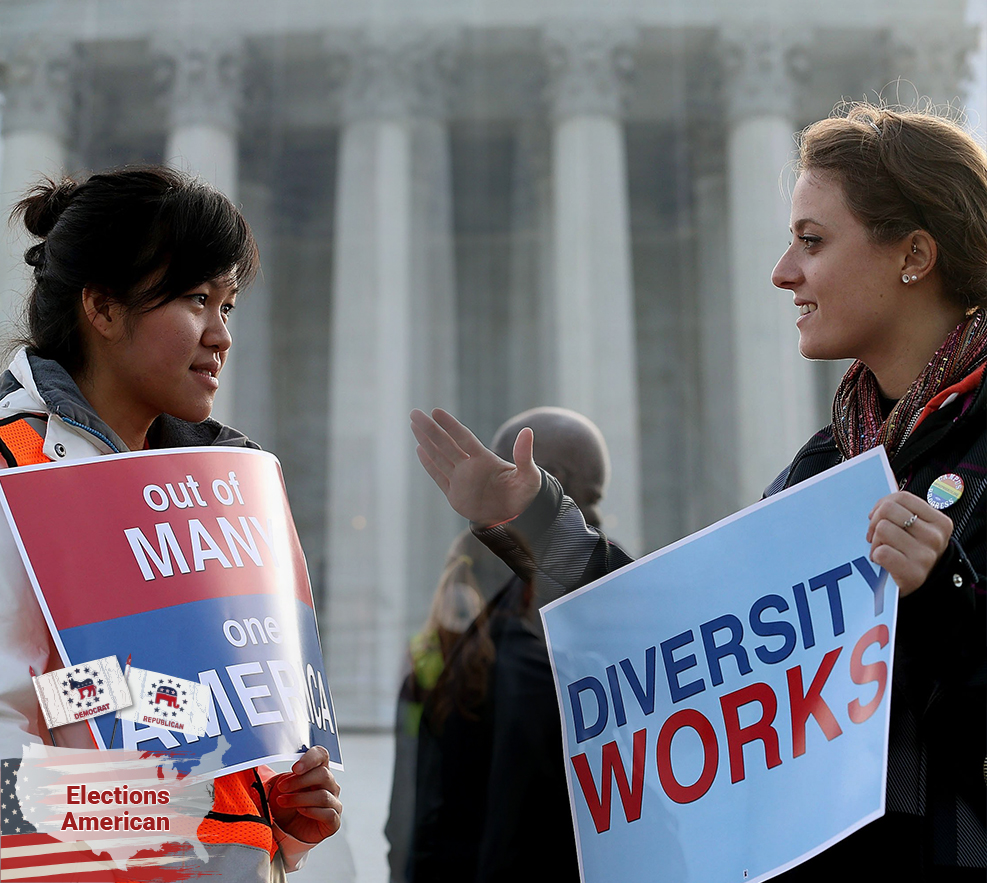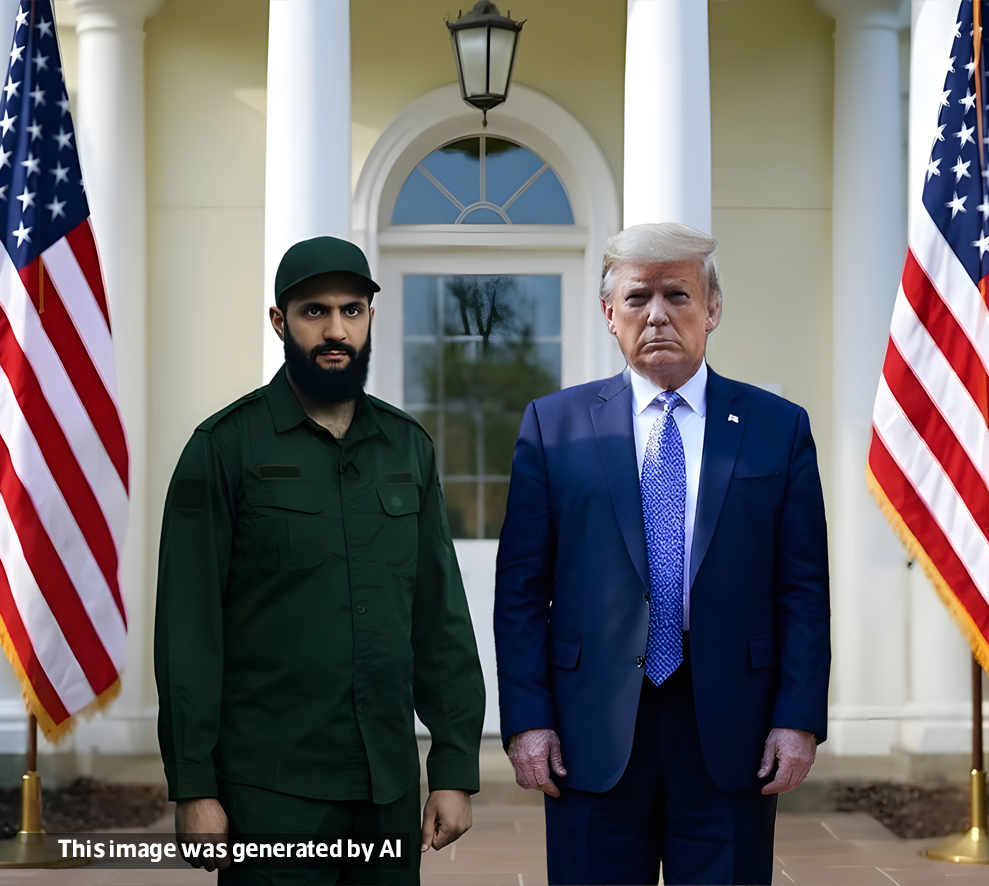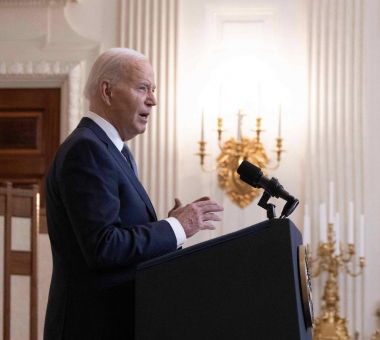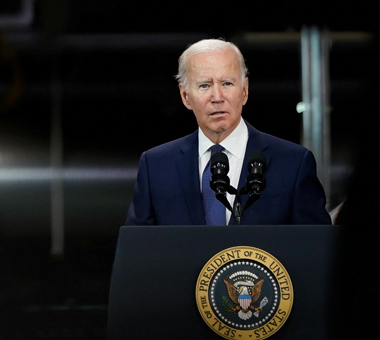* This is the second article in a set of articles and papers published successively, discussing certain aspects of the internal and foreign dimensions of the upcoming US elections.
The US presidential elections of this year is taking place at a time when the country has been witnessing a deepened political polarization consequent to the outbreak of the novel coronavirus with the accompanying economic collapse and disruption of many aspects of public life. The shock resulting from this pandemic has aggravated the feelings of frustration and impasse afflicting some social groups, the matter which accelerated the recent unrest that developed an ethnic and socio-economic character and was soon entrenched in the crucible of political divisions marking the four years of Donald Trump’s presidency.
In the midst of US response to the novel coronavirus crisis, a widely circulated video in late May 2020 showed a police officer "suffocating" a black American suspect named George Floyd, aged 46, although the suspect was not armed or posing an imminent threat that calls for the performance of any lethal subduing move, such as those performed by the policeman.
This video sparked widespread protests during which the protesters set fire to public buildings and demanded the imposition of concrete reforms on the work of law enforcement agencies and the enactment of legislation controlling the procedures and abuses of some of their affiliates. Surely, these protests cannot be seen as mere response to Floyd's killing, for many studies and rates clearly indicate the existence of structural imbalances in American society, and these imbalances are quite expanding.
This report provides a historical overview of the interaction between the US domestic political environment and demographic considerations, and tries to foresee the identity of the next president in light of the current tensions that would further draw these considerations into guiding the American electorate.
I Have a Dream!
The American Constitution has gone through several major amendments that kept pace with political changes. These changes cannot be taken independently of the path to independence and the creation of the US Constitution in 1787 after the northern states’ revolution against British rule. After the decline of the "British colonialist" in the aspects of American public life, the new society took its steps towards establishing general rules that attempt to balance the interests of the strong and the needs of the weak.
The struggle of the civil rights movements had a prominent role in defining the American political scene, as these movements supported basic rights and undermined what could be described as tools of official authoritarianism supported by vague and indefinite legislation.
These movements not only worked towards the abolition of slavery, but also supported the rights of women and the poor, who were, in the early stages of the founding of America, among the groups that were almost prohibited from exercising their voting rights; because a poor individual does not pay taxes or possess any property, he/she thus does not have the political capacity to participate in elections.
However, with the gradual development of public awareness accompanying the economic growth and improved livelihoods, most of these constitutional and legislative restrictions that impeded the establishment of state of citizenship on the basis of "rights and duties" have disappeared. However, practical obstacles preventing African Americans from voting, such as requiring a certain level of education and restricting them in the registration and voting procedures, remain.
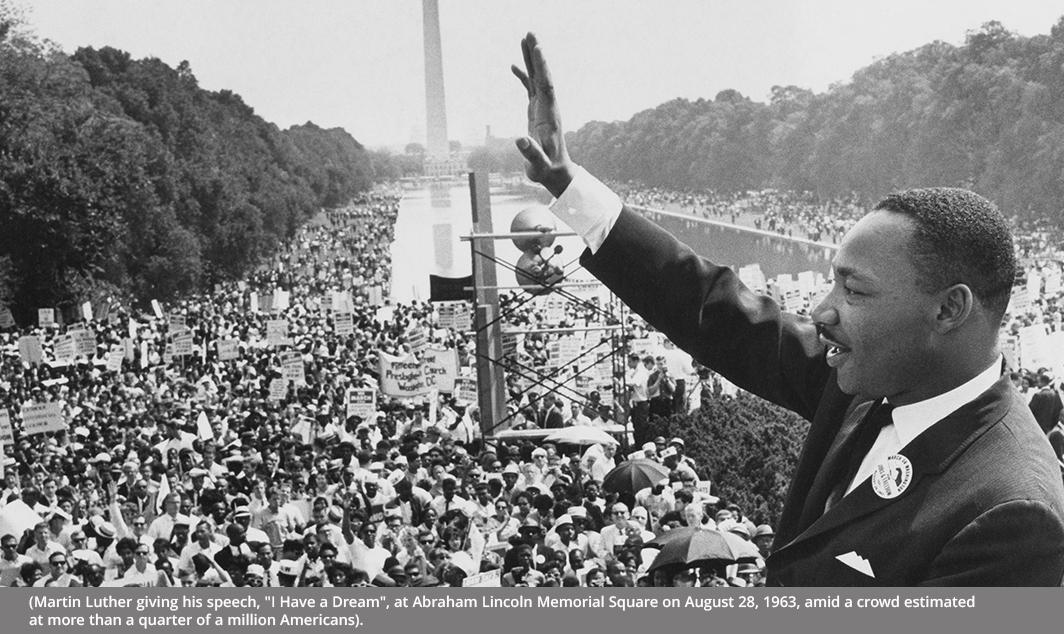
By 1965, the Voting Rights Act that allowed all Americans to exercise their voting rights was passed after a widespread movement led by the activist and Nobel Peace Prize winner in 1964, Martin Luther King. This movement created internal political pressure which the political class - regardless of its orientations - could not contain, especially since the state’s attention was focused on the requirements of deterring the Soviet Union, as the Cold War between the two camps was at its most intense.
This act is considered a turning point in the process of granting political rights to all people. This historical fact was emphasized by the former US President, Barack Obama, in a speech he gave in March 2015 to honor the participants in the "Selma" march, saying: "Fifty years ago, registering to vote here in Selma and much of the South meant guessing the number of jellybeans in a jar or bubbles on a bar of soap. It meant risking your dignity, and sometimes, your life."
Yet, this shift does not mean resolving identity controversies. It is true that the "official" discrimination ended, but the manifestations of "popular[ist]" racism are still clearly evident in American society up to this time, besides that these manifestations cannot be eradicated without realizing the historical background that accompanied the founding of America, the civil conflict that intermittently continued for long periods, and slavery abolition projects which were a subject of constant controversy and left their mark on political and even constitutional practices.
The "electoral college" is a striking example of the permanence of the discrimination methods, even though the prevailing aspects of constitutional and procedural restrictions had disappeared. Many American reports and studies agree on this fact, such as those of the African American Intellectual History Society, not to mention politically neutral academic opinions which criticize the presidential election mechanism. In this regard, the Harvard Magazine published in August 2020 an interview with Professor Alexander Keyssar, the author of Why Do We Still Have the Electoral College?
Critics of the electoral college argue that it is not consistent with the "one person, one vote" principle; because the election of the president is done through a college consisting of state delegates who are directly elected by the state’s residents, but these states’ representatives are not distributed based on the percentage of votes; rather, it is sufficient for a party to win more than 50% of the votes to obtain all the seats allocated to the state in the electoral college.
The roots of this practice can be traced back to the constitution-forming consultations in 1787, when representatives of southern states - particularly Virginia - rejected direct balloting, as these states contain the largest number of slaves, whereas the northern states contain a larger number of inhabitants, thus the "South" refused to agree to an electoral system that the candidates of the North would (almost) always win. The argument of the representatives of the southern states was that those who do not have adequate education will not have the appropriate political awareness to preserve democracy. Therefore, it was agreed upon an electoral system that excludes the votes of minorities that are inconsistent with the prevailing approach, as "the winner wins everything", without giving consideration to the votes that fall below 50% in each state.
The electoral college -which was described as contradicting to democracy values by several constitutional assessments- has led to the election of 4 American presidents despite not receiving the highest number of direct votes, and they were all Republican: Rutherford Hayes (1876), Benjamin Harrison (1888), George W. Bush (2000) Donald Trump (2016).
Generation Z
The statistics of the Pew Research Center, specialized in demographic issues, provide a deep insight into the link between race and the voting orientation of American voters, as shown in the following table based on figures published by the center in September 2020:
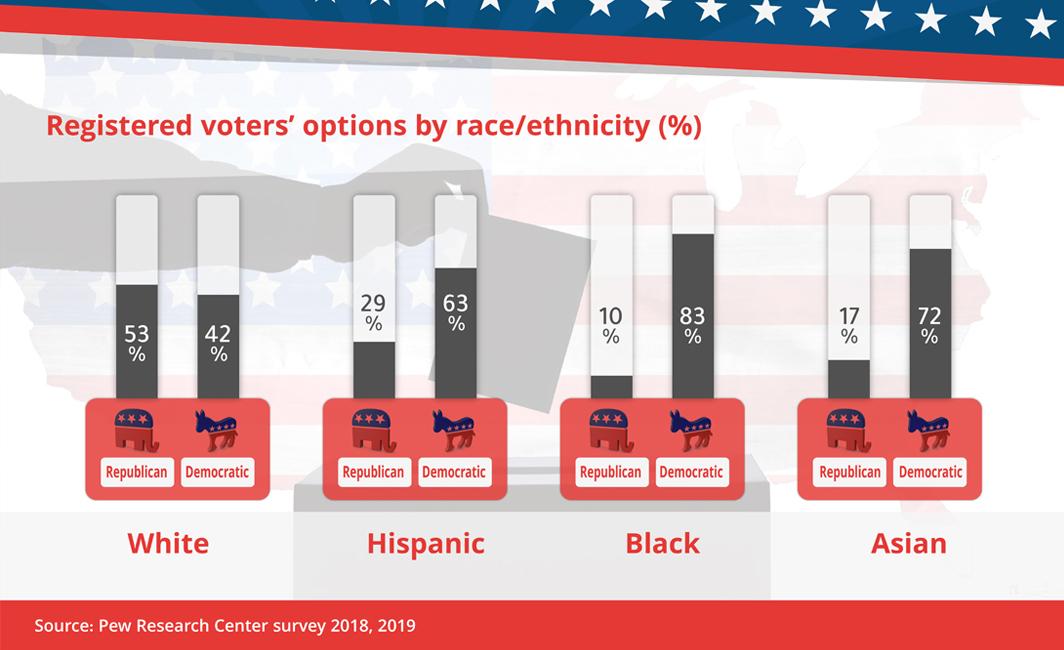
In order for these percentages not to give misleading statistical indicators, the voting patterns according to ethnic divisions must be taken into account. For white people usually participate in elections at a higher rate than other races, due to considerations related to the political heritage and the fact that a large percentage of those entitled to vote from other races are not totally convinced of the viability of the political process. The numbers of eligible voters of different races should also be kept in view, as eligible white voters make up 67.4% of the total number of voters. The following table, drawn from US Census Bureau data of 2018, shows the numbers of voters according to the prevailing racial divisions.
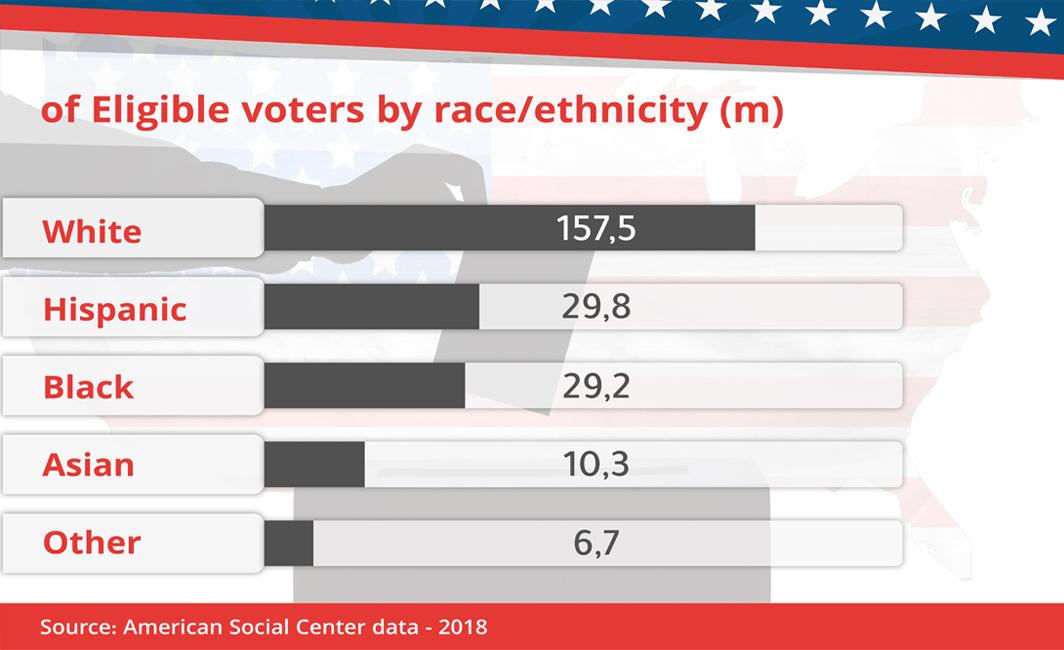
It can be seen from the graph that the number of eligible citizens of Hispanic origin will be higher than that of black citizens. According to some observers, these are the first presidential elections to take place with this demographic "shift", as black people form the second minority after the Hispanic.
The demographic aspects affecting voter decisions are not limited to race, but they also include demographics according to age; as cultural and party interests of people age-related. For young people usually adopt liberal ideas and are interested in issues such as education and job opportunities, whereas older people adopt conservative ideas and are interested in issues such as health care and post-retirement services.
Given the age divisions and whether specific age groups might give rise to any unexpected events, the voting behavior of Generation Z (people between 18 and 23 years old and will constitute approximately 10% of those eligible to vote in the upcoming presidential elections) should be observed. According to a report published by the Pew Research Center in January 2019, white people will make up about 55% of Generation Z, while those of other races will make up 45%, which means that this generation is, in its demographic composition, different from the general racial pattern of other age groups, as it was mentioned in an earlier part of this report that white people eligible to vote make up 67.4% of the total.
Specialists in American internal affairs must take into account these future changes. The rising age structure may have a decisive role in the upcoming election rounds if these rising groups are "entrenched" and molded into a specific partisan framework. Axios media company expects that by 2045 the United States will have a "majority minority", as the percentage of white people will be less than 50% of the total population.
Thus, with mathematical calculations, Americans will become accustomed to having a president who may not win the largest number of direct votes, but is put forward by the election mechanism of the electoral college.
Militarization of "elections"
In January 2020, STRATEGIECS Think Tank published a report on the New Zealand attacks in which a white supremacist extremist targeted two mosques in the city of Christchurch. The report examined the deep motives that drove the attacker and his relations with the extremist circles, for the perpetrator is not isolated from an environment from which he derives his philosophy and interpretations.
The report revealed that the roots of this philosophy go back to two main notions, namely: “Great Replacement,” the theory which was used by the perpetrator as a title of the manifesto he published on the Internet prior to executing the attack referring to the perceived risks of immigration on the demographic composition of the West.
The second notion concerns warning against a “White Genocide", one that is more of a cultural and moral nature, allegedly as a result of the demographic shift wrought by Western countries inhabitants who are ethnically and culturally different.
In the same vein, many white Americans fear a decline in their demographic advantage on the basis of "objective" studies that include rates of increase in the number of births and immigrants of non-white origins. Therefore, the "White Supremacy" groups are enthusiastic about political mobilization and galvanizing all hesitant people to vote for the Republican candidate, Donald Trump.
Trump's campaign did not go on without controversies and accusations made by Democratic and independent figures calling the campaign for an explicit condemnation of these groups. However, the campaign is evading this condemnation, and Trump insists on supporting the federal state apparatus in their effort to impose "Law & Order" against the chaos caused by left-wing anarchist extremists in the protest squares after the killing of Floyd.
In this polarized domestic environment, it is difficult to predict who will be the next president. On the one hand, fear of the continuing division may drive Americans to vote for the Democratic candidate, Joe Biden. On the other hand, the security incidents that accompanied the movement of groups like "Black Lives Matter" and the "Antifa" stimulated the right-wing nationalist sentiments of many white people, the matter which may increase the turnout in the vote for Trump.
The advocates for the preservation of "Great & White America" intersect with another component that makes up a quarter of the American population, i.e., the evangelical Protestants. A poll conducted by the Public Religion Research Institute found that 77% of them support President Trump. A report published by Independent Arabia in October 2020 titled "Will Church decide the American Elections Again?", states that this component is located in a geographical area called the "Bible Belt" in states that elect 149 of the 538 electoral college members.
Some may think that speaking of demographic and religious factors affecting such a secular deep-rooted political system is a kind of "allegation" and exaggeration, as the United States continues to be a "Land of Immigrants" and a "Land of Opportunity" despite these deepening social imbalances.
This proposition may be true; yet, to form a comprehensive and accurate vision, all influencing factors must be taken into account. Theoretically speaking, race and sect cannot be put aside when speaking of the orientations of American voters. Practically and historically, on the other hand, almost all American presidents have been of White Anglo-Saxon Protestants (WASP), and only rarely any president has been elected except from the WASP, like the Catholic president of Irish descent, John F. Kennedy who was assassinated under mysterious circumstances while performing a presidential event in 1963.
US Divisions: circumstantial & temporary or radical & chronic?
No doubt that the outbreak of the coronavirus has caused a shock on the social, economic and psychological levels, the matter which exacerbated the political and ideological divisions in the American society. In the event of economic and social conditions deterioration, it is not unusual for individuals to resort to "identity" to express their anger and frustration. Therefore, US demographics cannot be evaluated from an "ideological" perspective, but rather as a case of economic and structural imbalances in the political system, the imbalances which have given rise groups that are not represented in the general political scene.
In addition to the outbreak of the coronavirus, the exclusionary extremist discourse, with its hate speech against the "Other", has exacerbated the repercussions of these imbalances. Therefore, instead of denouncing and rejecting cases of unprecedented mutual violence in the modern American history, these violent manifestations -which reignite the atmosphere of "civil war"- must be eradicated, stripped of their political and security cover, in addition to criminalizing extremist speech, so that the audacity to publicize such ideas is not elevated to the extent of carrying out operations of extremist ideological character.
Observers fear the occurrence of violent incidents on Election Day around polling stations, given the state of tension in which the US is holding the elections. According to a report published by Business Insider in October 2020, far-right groups are preparing to deploy armed patrols on polling day and entering balloting stations with arms, which is prohibited in some states. However, the right to keep and bear arms for every American is a constitutional right granted by the Second Amendment, so no state law can prohibit the possession of arms unless a constitutional amendment is made, the event which seems unlikely in the present circumstances.
No violence is expected to disrupt the electoral process; however, some observers fear that the losing candidate - whoever he might be - will not accept the election result if the difference in the outcome is minor. These concerns are considered valid, as this is almost the first election in which presidential campaigns have questioned the integrity of election processes, such as the Trump campaign questioning the integrity of mail-in ballot.
Hence, the next president - whomsoever – shall face the challenge of restoring the American national identity and the national cohesion that has been exhausted by partisan dissonances and multiple gaps. Many of those who accept the extremist rhetoric at this stage are but "temporary extremists" not extremist ideologists, which means that they are ready to come to their senses when an honest political will is there in the hearts of the ruling elite of both Democrats and Republicans.
The issue of identity, despite its complications, is naturally capable of resolving the issues that arise on and within it. For identity is the first answer that comes to mind for the following question: “Who am I?”. If it were “I am American,” then there would be no signs of division and this report would not have been written.
Keep in touch
In-depth analyses delivered weekly.

Related Analyses:







